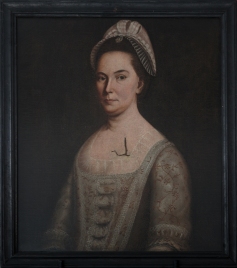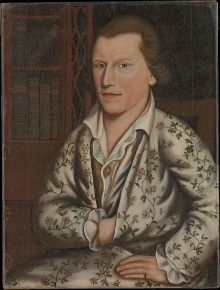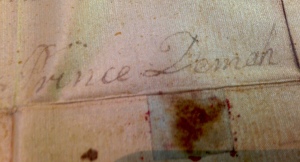One of our Society’s co-founders, Susan Barker Willard, bequeathed a treasure trove of art, furniture, and documents which she had inherited from her Barker, Thaxter, and Willard family ancestors. Much of it has furnished our 1688 Old Ordinary house museum since the early part of the last century. Two paintings in particular have always been favorites, especially on the fifth grade school tours that are a rite of passage in the Hingham Public Schools. They are a pair of 18th century oil portraits of Henry and Christian Barnes of Marlborough, Massachusetts.
Henry Barnes had no family connection to our town of Hingham, but Christian had friends and relatives here. Her mother’s family were Barkers from the South Shore. Henry was a distiller, manufacturer of pearl ash (an early chemical leavener), and trader in British manufactured goods. They were Loyalists and forced to flee Marlborough for England in late 1775 after some violent incidents (including, it has been reported, the tarring and feathering of Henry’s horse). The Barnes portraits are each damaged in the chest area, and the lore is that the portraits—left at their estate—were the victims of Marlborough patriots.
Members of Marlborough’s financial elite, the Barneses owned three slaves in the early 1770s. Thanks to Christian’s prolific correspondence, we have known for some time that Prince, the son of their slave Daphney, was a talented artist. (Prince’s mother, Daphney, features in a set of letters in our archives. She was the subject of an earlier post in this blog, “A Letter from Daphney.”) In the first letter that mentions Prince, Christian writes, that “Prince is here and I am sitting to him for my picture.” A month later, in November 1769, she reports that Henry has purchased Prince, with a view towards “improving his genius in painting.” From there, Christian’s appreciation for Prince’s talent grows. In an early 1770 letter, she reports that he is
a most surprising instance of the force of natural Genius for without the least instruction or improvement he has taken several faces which are thought to be very well done. He has taken a copy of my picture which I think has more of my resemblance than Copling’s [sic].
(She is referring to John Singleton Copley, a colonial American painter famous for his portraits of 18th century Bostonians.)
The original manuscripts of Christian’s letters are at the Library of Congress, but we are lucky to have, in our Old Derby Academy archives, a set of typescripts made in the early 20th century—also the gift of Susan Barker Willard. In her letters, among her friends, and even in a set of newspaper advertisements, Christian passed the word about Prince:
As soon as the roads are tolerable I propose going to Boston in order to recommend our Limner to the Publick. I should be glad to have your judgment as to his performance and likewise your advice how I shall proceed with him. He has taken five pictures from the life since his return. Three of them as good likenesses as ever Mr. Copling took. I am in no doubt but he could coppy a picture as well as anybody in the Country.
Christian’s enthusiasm made it impossible for us to stop thinking about Prince the painter—particularly since our two Barnes portraits were painted in the 1770s and were unattributed. We continued to learn more about Prince and his remarkable life but were unable to connect the dots between Prince and the Barnes portraits. (The paintings are unsigned and when they were restored in the 1930s a heavy layer of masonite was placed over the back of the canvas, obliterating any obvious clues.
In late 2013, the Metropolitan Museum of Art in New York opened an exhibit called “Interwoven Globe,” on the 18th century international trade in textiles. The exhibition included a modest portrait of a Scottish textile merchant, painted in 1773 and signed, on a stretcher on the back of the canvas, “Prince Demah Barnes.”
We got in touch with the Metropolitan and were able to share what we had learned about Prince. The Metropolitan invited us to bring our two portraits to its Paintings Conservation Department, where they were examined using x-radiographs and infrared reflectography. The Metropolitan concluded that its signed painting by Prince and our two Barnes portraits were all by the same artist. We have co-authored an article about the three paintings which appears in this month’s issue of Antiques magazine.
Prince enjoyed a short professional painting career before the Revolution changed the lives of Christian, Henry, and Prince. Christian and Henry fled and Prince enlisted in the Massachusetts militia as a free man–Prince Demah (no more “Barnes”)–and served as a matross. He died, likely of smallpox or other disease, in March 1778. As “Prince Demah, limner,” he wrote his will, leaving all he had to Daphney.
These three portraits by Prince Demah are the earliest known paintings by an African-American to be located and identified. It appears that Prince was only allowed to focus on his art for around ten years, but we know that he made other portraits as well—in oils and with “crayons,” or what we call pastels today. The next step: seeing if we can identify any more of his paintings. As we at the Hingham Historical Society now know, one (or two) of them could be found just about any place.




[…] museum, the Old Ordinary, have now been attributed to an enslaved African American artist. Prince Demah‘s short life was eventful and included painting lessons in London, a brief commercial career […]
Regarding the origins of Prince Demah, it is interesting that Hannah Thaxter Barker’s grandfather Samuel Thaxter, who died in 1740, left his “Negroes” (he did not use the word “slaves”) to his various grandchildren, and among them was a “negro man” named Prince. The name Daphne was not there; the names (if my understanding of the text is accurate) were Frances, Prince, Caesar, Piso, and Ishmael. Samuel’s property shared a property line with the Old Ordinary, being immediately to the east of it. If Prince was a “man” as opposed to a “boy” in 1740 he would likely be too old to be the painter, but the coincidence seemed worth mentioning. Hannah Thaxter Barnes did not receive a slave, but she did receive 500 pounds which may have helped to pay for the purchase of the Old Ordinary!
[…] Enslaved African-American artist Prince Demah solicited commissions for portrait work, advertising in the Boston News-Letter that he “takes […]
Do you know where Prince and his mother Daphne are buried ?
Not the physical graves, no. The record of Prince’s death is from Trinity Church, Boston (the predecessor to the current Episcopal church in Copley Square). Daphne’s death is found
in the records of Boston’s Almshouse.
Is it possible that Daphne Demah is connected to Daphne, Barker’s slave of Hanover Mass? Dick, James Bailey’s negro and Daphne, Col Barkers negro married 25 Dec 1741 in Hanover Mass. He is referred to later in the records as King Dick and she as Queen Daphne. They were unable to read and write when they asked Col John Bailey to write a letter on there behalf to their friends on the cape. There is also a Daphne, d. of Oxford who was baptized in Marlborough Mass on 27 May 1764. Dill Oxford ch. was baptized on 29 June 1766 Marlborough Mass. And Oxford servant of Mr Speakman baptized 5 Dec 1762. Dill Oxford remained in Marlborough. see p 396 for Dill’s owners. https://archive.org/details/historyoftownofm00huds/page/396
I realize this is an old post but i just discovered it.
I decided to reply because i have what appears to me as an old lid to some sort of container that has a portrait painted on it of a very attractive young lady.
The portrait is signed RE Pine and under that is a signature Prince Demah Barnes.
The backside of this ” lid” shows some sort of a coat of arms type symbol with wheat , a sythe and other grains. A brown material similiar to masonite maybe encompasses it with moon shapes cut into it. Through the cuts one can see a mother of pearl looking material.
An odd piece but a very nice mini portrait.
Anyone know anything about what this may be / have been?
Lester, this is very exciting. From the date and time of your post I assume you are in England? Would it be possible to send a photograph or two of your item? I can best be reached at president@hinghamhistorical.org.
Lester, I am an art historian preparing a presentation on Prince Demah Barnes for an academic conference and would very much like to see photographs of the work you own. Please email judy.bullington@belmont.edu. Thank you!
Hi Judy,
Thank you for contacting me. I will send you some pictures of the piece to your email address. Please know that the signature of Prince Demah is one that i had to use a magnifier lens on and though i think i got a pretty good shot of it, it is right along the edge of the piece. I wouldn’t want to try to disassemble the piece for a better picture at all as it would destroy the work.
Please let me know if i can be of any further assistance.
Marvin Lester Gelhar
Knoxville Tn.
Hi Lester. I would also very much like to see the photo. Would you be willing to send it to president@hinghamhistorical.org?
[…] Article by Paula Bagger about rediscovering Prince Demah in the Hingham Historical Society archives (includes Prince’s portraits of Henry and Christian Barnes) […]
[…] with one of Christian Barnes and another of a Scottish merchant William Duguid, are three of the earliest known portraits by an African-American artist. The paintings of Henry and Christian Barnes are currently in the collection of the Hingham […]
[…] Article by Paula Bagger about rediscovering Prince Demah in the Hingham Historical Society archives (includes Prince’s portraits of Henry and Christian Barnes) […]